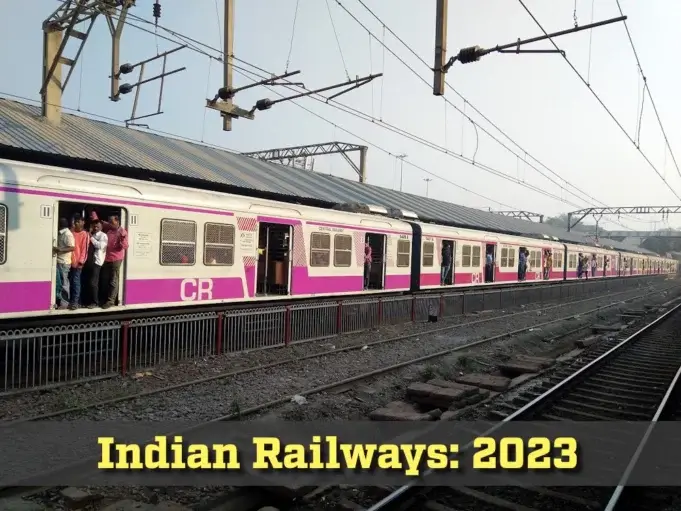In the year 2023, Indian Railways has witnessed remarkable progress on multiple fronts, marking a significant stride towards modernization and efficiency. From the substantial increase in freight loading and revenue to the introduction of cutting-edge Vande Bharat Trains, massive capital allocation, station redevelopment initiatives, Kavach implementation for safety, extensive track laying, and electrification endeavors, the Indian Railways has been on a transformative journey.
The Gross Budgetary Sanction (GBS) for the year 2023-24 reached an impressive Rs 2.4 lakh crore, a stark contrast to just Rs 29,055 crore allocated in the 2013-14 Railway budget.
In the fiscal year 2023-24, during the cumulative period from April to November, Indian Railways achieved a remarkable freight loading of 1015.67 million metric tons (MT), surpassing the previous year’s loading of 978.72 MT by 36.945 MT. This achievement translated into a revenue of Rs 1,10,007.50 crore, compared to Rs 1,05,905.10 crore from the previous year.
The electrification drive has been equally impressive, with 21,801 km of the broad gauge network electrified until 2014. By November 2023, the total electrified broad gauge network extended to 60,814 km. Notably, 14 states and union territories have achieved the milestone of 100 percent electrification of their rail tracks, including Chandigarh, Chhattisgarh, Delhi, Haryana, Himachal Pradesh, Jammu & Kashmir, Jharkhand, Madhya Pradesh, Meghalaya, Odisha, Puducherry, Telangana, Uttar Pradesh, and Uttarakhand.
The track laying efforts have also seen significant progress. In the period from 2014 to 2023, a total of 25,871 route km (RKM) of track laying work was completed, surpassing the 14,985 RKM achieved during the years 2004-2014. The goal for the year 2022-23 was to lay 14 km of track per day, with plans to further increase the target to 16 km per day in the current year.
The Vande Bharat Train Service has been a notable success, with 35 indigenously designed semi-high-speed, Vande Bharat Express trains serving passengers across the nation. Additionally, plans are underway to launch six more Vande Bharat trains covering up to 247 districts.
Introducing the Amrit Bharat Trains, the Indian Railways is set to unveil the Darbhanga-Ayodhya-Anand Vihar Terminal Amrit Bharat Express and the Malda Town-Sir M. Visvesvaraya Terminus (Bengaluru) Amrit Bharat Express by end December.
In a bid to modernize passenger amenities and enhance accessibility and inclusivity, the Indian Railways has identified 1,309 Amrit Bharat Stations across the country.
The Indian Railways has also undertaken several groundbreaking projects. Notable among them is the Jiribam-Imphal new line spanning 110.63 km, connecting Manipur at a cost of Rs 14,323 crore, with a remarkable 93 percent physical progress. Additionally, the construction of the world’s highest pier bridge, with a towering pier height of 141 meters over the river Ijai near Noney, is nearing completion.
Work on the iconic Chenab Bridge, the world’s highest railway bridge, is also drawing to a close. The first trial run on a track-mounted vehicle was conducted in March 2023, marking a significant milestone.
Other noteworthy projects include the trial run of a Kolkata Metro rake under the Hooghly River, nearing completion of the Pamban Bridge, and the progress of the Rishikesh-Karnaprayag Char Dham project.
The ambitious Mumbai-Ahmedabad High-Speed Rail Corridor has seen substantial developments, with all civil contracts awarded for Gujarat and Maharashtra, along with significant progress in land acquisition.
Furthermore, works on the eight High-Speed Rail (HSR) Stations are progressing steadily, and the completion of the first mountain tunnel near Zaroli Village in Valsad, Gujarat, stands as a remarkable achievement, completed in just 10 months.
In a bid to boost investment in rail cargo handling, the ‘Gati Shakti Multimodal Cargo Terminal (GCT)’ policy was launched on 15 December 2021. In 2023, 51 GCTs were commissioned, with around 80 more locations identified for further development.
The Dedicated Freight Corridor (DFC) project, which had seen no commissioning before 2014, has made substantial progress. Almost the entire Eastern Dedicated Freight Corridor (EDFC) is completed, and the Western Dedicated Freight Corridor (WDFC) is on the verge of completion, with 2,513 km commissioned, constituting approximately 90 percent of the DFC network. Notably, the Ludhiana to Sonnagar stretch of EDFC spanning 1337 km has been successfully completed, signifying a transformative milestone in the rail infrastructure landscape.
More capex is expected to be poured into modernising the Indian Railways services in the coming years.
Cover Picture: pixabay.com











